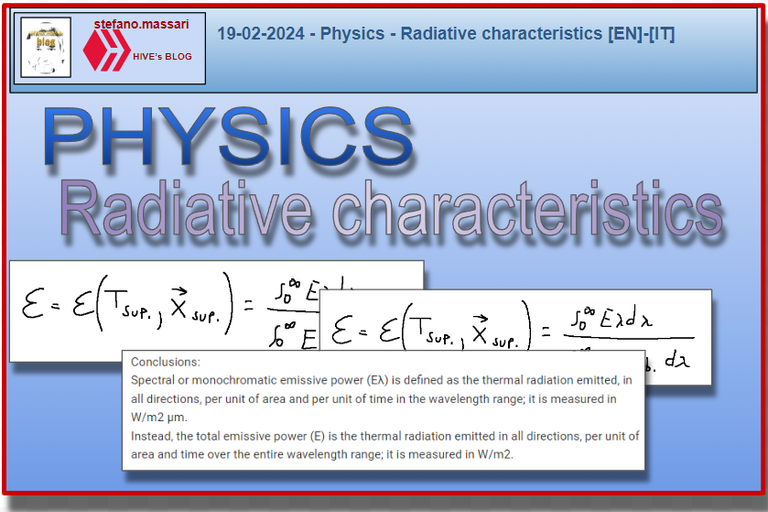19-02-2024 - Physics - Radiative characteristics [EN]-[IT]

~~~ La versione in italiano inizia subito dopo la versione in inglese ~~~
ENGLISH
19-02-2024 - Physics - Radiative characteristics [EN]-[IT]
Basic concepts
Thermodynamics is a very vast topic and it is good to remember some basic concepts.
The second law of thermodynamics for an isolated system states that it is not possible to create a heat machine capable of transforming all the heat into work.
Below are some basic concepts of thermodynamics.
In the drawings that depict thermodynamic systems we could see thermal or mechanical tanks schematized. These are like large systems that enjoy the property that the intensive variable associated with the permitted flows always remains constant.
It is likely that when we see some drawings representing thermodynamic studies we come across the word SET. In graphic representations the word SET identifies a thermal tank that only allows heat exchanges, following which its temperature does not vary.
Surface and total radiative characteristics
When we talk about superficial and total radiative characteristics it means that we are in the field of electromagnetism.
The electromagnetic radiation emitted by a body by radiation varies
as the temperature of the body, the wavelength, the
material constituting the body and the surface treatment of the latter.
In this field the black body is an object that absorbs all the incident electromagnetic radiation and does not reflect it. The black body is an ideal body that re-radiates all the absorbed energy, in fact the black body emits the maximum radiant energy for each wavelength at every temperature.
Regarding the black body we can write the following formula which is the monochromatic emission, or also spectral emission.

The relationship just written, i.e. the monochromatic emission, is a function of the thermodynamic state of the emitting surface, i.e. it is a state function
The total emission will instead be described by the following formula:

Conclusions:
Spectral or monochromatic emissive power (Eλ) is defined as the thermal radiation emitted, in all directions, per unit of area and per unit of time in the wavelength range; it is measured in W/m2 µm.
Instead, the total emissive power (E) is the thermal radiation emitted in all directions, per unit of area and time over the entire wavelength range; it is measured in W/m2.
Request
Have you carried out studies on electromagnetic radiation in the past?

19-02-2024 - Fisica - Caratteristiche radiative [EN]-[IT]
Concetti base
La termodinamica è un argomento molto vasto ed è bene ricordare qualche concetto base.
La seconda legge della termodinamica per un sistema isolato stabilisce che non è possibile realizzare una macchina termica capace di trasformare tutto il calore in lavoro.
Qui di seguito alcuni concetti base della termodinamica.
Nei disegni che raffigurano sistemi termodinamici potremmo vedere schematizzati i serbatoi termici o meccanici. Questi sono come dei sistemi di grandi dimensioni che godono della proprietà che la variabile intensiva associata ai flussi consentiti rimane sempre costante.
E' probabile che quando vediamo alcuni disegni che rappresentano degli studi termodinamici incontriamo la parola SET. Nelle rappresentazioni grafiche la parola SET identifica un serbatoio termico che consente solo scambi di calore, in seguito ai quali la sua temperatura non varia.
Caratteristiche radiative superficiali e totali
Quando parliamo di caratteristiche radiative superficiali e totali vuol dire che siamo nel campo dell’elettromagnetismo.
La radiazione elettromagnetica emessa da un corpo per irraggiamento varia
al variare della temperatura del corpo, della lunghezza d'onda, del
materiale costituente il corpo e del trattamento superficiale di quest’ultimo.
In questo campo il corpo nero è un oggetto che assorbe tutta la radiazione elettromagnetica incidente e non la riflette. Il corpo nero è un corpo ideale che re-irradia tutta l'energia assorbita, infatti il corpo nero emette ad ogni temperatura la massima energia raggiante per ogni lunghezza d’onda.
A riguardo del corpo nero possiamo scrivere la seguente formula che è l’emittenza monocromatica, o anche emittenza spettrale.

Il rapporto appena scritto, cioè l’emittenza monocromatica, è in funzione dello stato termodinamico della superficie emittente, cioè è una funzione di stato
L’emittenza totale sarà invece descritta dalla seguente formula:

Conclusioni:
Si definisce potere emissivo spettrale o monocromatico (Eλ ) la radiazione termica emessa, in tutte le direzioni, per unità di area e per unità di tempo nell’intervallo di lunghezze d’onda; si misura in W/m2 µm.
Invece il potere emissivo totale (E) è la radiazione termica emessa in tutte le direzioni, per unità di area e di tempo su tutto il campo di lunghezze d’onda; si misura in W/m2.
Domanda
Avete effettuato in passato studi sulla radiazione elettromagnetica?
THE END
Thermodynamics seem to be a long course but I am enjoying the clasS
Thank you for it
This topic can be a bit complex, it is even little discussed in some schools. Here I am talking about monochromatic or spectral emission. Monochromatic emission is a function of the thermodynamic state of the emitting surface.
I have read about thermodynamics a little in the past, and this particular lesson is interesting, I learnt one or two things. Thanks for writing and have a great day.
We are starting to delve into a complicated field, that of monochromatic broadcasting. The main thing to remember is to clarify clearly what monochromatic emission depends on. It is a function of the thermodynamic state of the emitting surface. One might mistakenly think that it depends on the temperature of the surface, but instead it depends on the thermodynamic state of the emitting surface. Below I report how monochromatic or spectral emission is written.

Non ho mai studiato questo argomento
Il cuore di questo articolo è l'emissività e questa esprime la capacità di irraggiamento di un corpo e ci dice in che percentuale esso è in grado di emettere energia... questo articolo parte proprio da questo concetto. Poi la cosa più interessante scritta qui è che l'emittenza monocromatica è una funzione dello stato termodinamico della superficie emittente, non è in funzione della temperatura della superficie emittente come erroneamente si potrebbe pensare.
Thermodynamic is one of the topic I so much love and will want to contually learn of also
Thanks for stopping by. The beginning of everything is to understand what thermodynamics is. This is the branch of classical physics that studies the thermodynamic transformations induced by heat and work in a system. In this article I talk about monochromatic emission. The main thing to understand is that this is a function of the thermodynamic state of the emitting surface. It is not a function of temperature and it is not a function of the transmitted energy of the emitting surface.
In as much as the world of thermodynamic is wide, I believe the heat topic can't do without the concept
Thanks for stopping by!!In this article I talk about spectral and total surface radiative characteristics. The most interesting thing about this article is knowing that monochromatic radivity is a function of the thermodynamic state of the emitting surface. Another thing regarding the spectral emission, this can be determined using models:
!DHEDGE
!discovery 30
Grazie Liberty per il supporto... L'unica cosa importante di questo articolo è ricordare che l'emittenza monocromatica è una funzione dello stato termodinamico della superficie emittente
This post was shared and voted inside the discord by the curators team of discovery-it
Join our Community and follow our Curation Trail
Discovery-it is also a Witness, vote for us here
Delegate to us for passive income. Check our 80% fee-back Program
grazie per il sostegno
This post has been selected for upvote from our token accounts by @libertycrypto27! Based on your tags you received upvotes from the following account(s):
- @dhedge.bonus
- @dhedge.ctp
- @dhedge.pob
- @dhedge.neoxag
- @dhedge.waiv
- @dhedge.stem
@libertycrypto27 has 2 vote calls left today.
Hold 10 or more DHEDGE to unlock daily dividends. Hold 100 or more DHEDGE to unlock thread votes. Calling in our curation accounts currently has a minimum holding requirement of 100 DHEDGE. The more DHEDGE you hold, the higher upvote you can call in. Buy DHEDGE on Tribaldex or earn some daily by joining one of our many delegation pools at app.dhedge.cc.